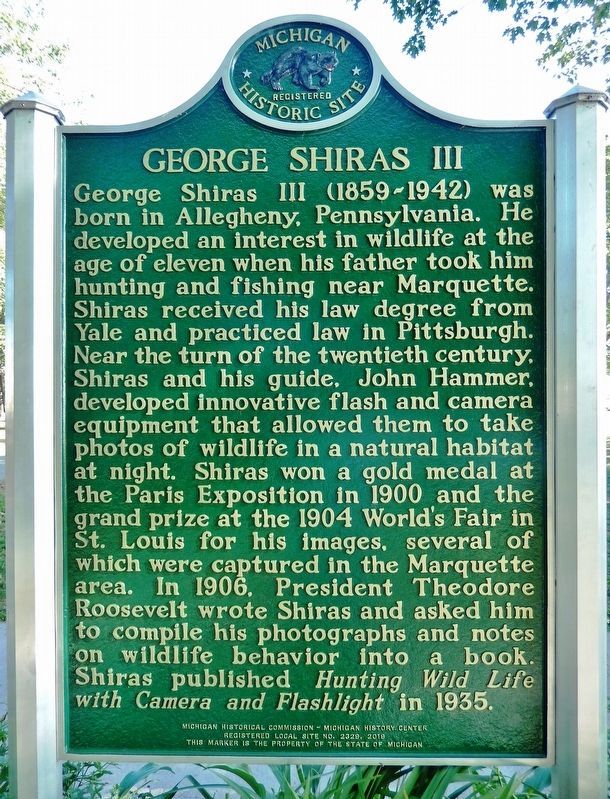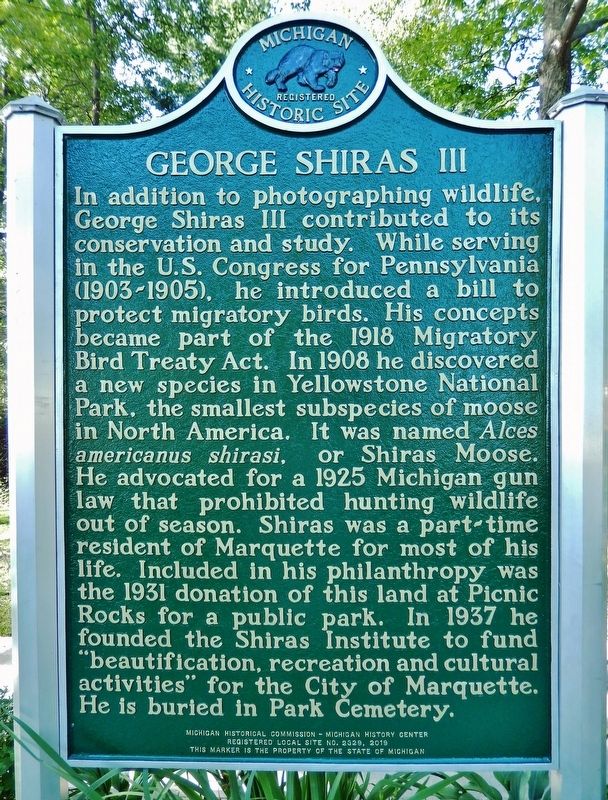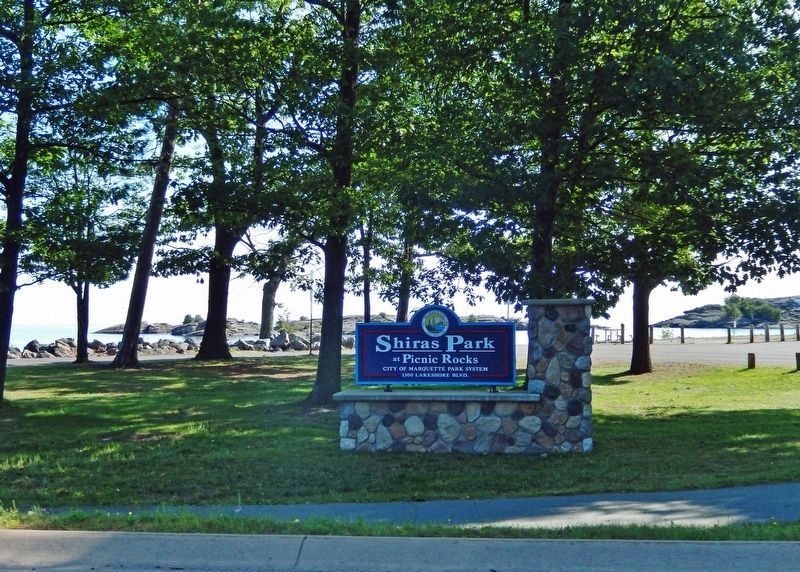Marquette in Marquette County, Michigan — The American Midwest (Great Lakes)
George Shiras III
[south side]
George Shiras III (1859-1942) was born in Allegheny, Pennsylvania. He developed an interest in wildlife at the age of eleven when his father took him hunting and fishing near Marquette. Shiras received his law degree from Yale and practiced law in Pittsburgh. Near the turn of the twentieth century, Shiras and his guide, John Hammer, developed innovative flash and camera equipment that allowed them to take photos of wildlife in a natural habitat at night. Shiras won a gold medal at the Paris Exposition in 1900 and the grand prize at the 1904 World’s Fair in St. Louis for his images, several of which were captured in the Marquette area. In 1906, President Theodore Roosevelt wrote Shiras and asked him to compile his photographs and notes on wildlife behavior into a book. Shiras published Hunting Wild Life with Camera and Flashlight in 1935.
[north side]
In addition to photographing wildlife, George Shiras III contributed to its conservation and study. While serving in the U.S. Congress for Pennsylvania (1903-1905), he introduced a bill to protect migratory birds. His concepts became part of the 1918 Migratory Bird Treaty Act. In 1908 he discovered a new species in Yellowstone National Park, the smallest subspecies of moose in North America. It was named Alces americanus shirasi, or Shiras Moose. He advocated for a 1925 Michigan gun law that prohibited hunting wildlife out of season. Shiras was a part-time resident of Marquette for most of his life. Included in his philanthropy was the 1931 donation of this land at Picnic Rocks for a public park. In 1937 he founded the Shiras Institute to fund “beautification, recreation and cultural activities” for the City of Marquette. He is buried in Park Cemetery.
Erected 2019 by Michigan Historical Commission - Michigan History Center. (Marker Number L2329C.)
Topics and series. This historical marker is listed in these topic lists: Animals • Arts, Letters, Music • Charity & Public Work • Parks & Recreational Areas. In addition, it is included in the Former U.S. Presidents: #26 Theodore Roosevelt, and the Michigan Historical Commission series lists. A significant historical year for this entry is 1900.
Location. 46° 33.27′ N, 87° 22.97′ W. Marker is in Marquette, Michigan, in Marquette County. Marker can be reached from the intersection of Lakeshore Boulevard and Lakeshore Park Place Drive, on the right when traveling north. Marker is located beside the City Multi Use Path in Shiras Park. Touch for map. Marker is at or near this postal address: 1300 Lakeshore Boulevard, Marquette MI 49855, United States of America. Touch for directions.
Other nearby markers. At least 8 other markers are within walking distance of this marker. Picnic Rocks Memorial (within shouting distance of this marker); Northern's Original Campus (approx. 0.7 miles away); World War II "Silent Service" Memorial (approx. 0.8 miles away); First Steam Railroad in Upper Peninsula (approx. 0.9 miles away); The Barracks Boys (approx. 0.9 miles away); In Memory of NMU War Veterans (approx. 0.9 miles away); Marquette Fire Department (approx. 0.9 miles away); Northern Michigan University (approx. 0.9 miles away). Touch for a list and map of all markers in Marquette.
Also see . . .
1. George Shiras III.
Both during and after his time in Congress, Shiras participated in biological research and photography, to the extent that National Geographic has described him as "the father of wildlife photography" for his early use of camera traps and flash photography. On February 14, 1906, Shiras was elected Associate Member of the Boone and Crockett Club, a conservation organization founded by Theodore Roosevelt in 1887. Collections of his papers are held at the National Library of Medicine and the Central Upper Peninsula and Northern Michigan University Archives.(Submitted on September 14, 2022, by Cosmos Mariner of Cape Canaveral, Florida.)
2. George Shiras III – First Wildlife Photographer.
Shiras returned every summer to Marquette, Michigan for over 70 years. During his early years, the interests of George Shiras III were those of a keen hunter and fisherman. As he grew older and his viewpoint broadened, he became more and more enthralled by the wildlife and the beauties of the region where he had passed so many years. By the late 1880s his hunting instincts had been more and more replaced by the sympathetic desire of the naturalist to know more of the lives, habits, and mentality of the wild things he so often encountered. Whatever that quality was, by 1889, his 30th year, he largely lay gun and rod aside in favor of a more absorbing instrument: the camera.(Submitted on September 14, 2022, by Cosmos Mariner of Cape Canaveral, Florida.)
3. New Book Sheds Light on George Shiras III.
Northern Michigan University professor James McCommons recently published a definitive biography of George Shiras III, the groundbreaking wildlife photographer who honed his techniques in Michigan's Upper Peninsula. His “camera trap” invention was a primitive precursor to the modern trail cam. “It was a box camera holding a glass negative rigged to a chemical flare of magnesium and potassium chlorate powder,” wrote McCommons in Camera Hunter: George Shiras III and the Birth of Wildlife Photography. “When a deer stumbled into a trigger wire, the shutter released and the chemicals exploded with the force of a mortar, flooding the woods with a sizzling, brilliant light. Pictures revealed wide-eyed, startled animals, muscles tensed for flight. It was a crude setup, but one that yielded extraordinary images.”(Submitted on September 14, 2022, by Cosmos Mariner of Cape Canaveral, Florida.)
Credits. This page was last revised on September 14, 2022. It was originally submitted on September 14, 2022, by Cosmos Mariner of Cape Canaveral, Florida. This page has been viewed 159 times since then and 27 times this year. Photos: 1, 2, 3, 4, 5. submitted on September 14, 2022, by Cosmos Mariner of Cape Canaveral, Florida.




